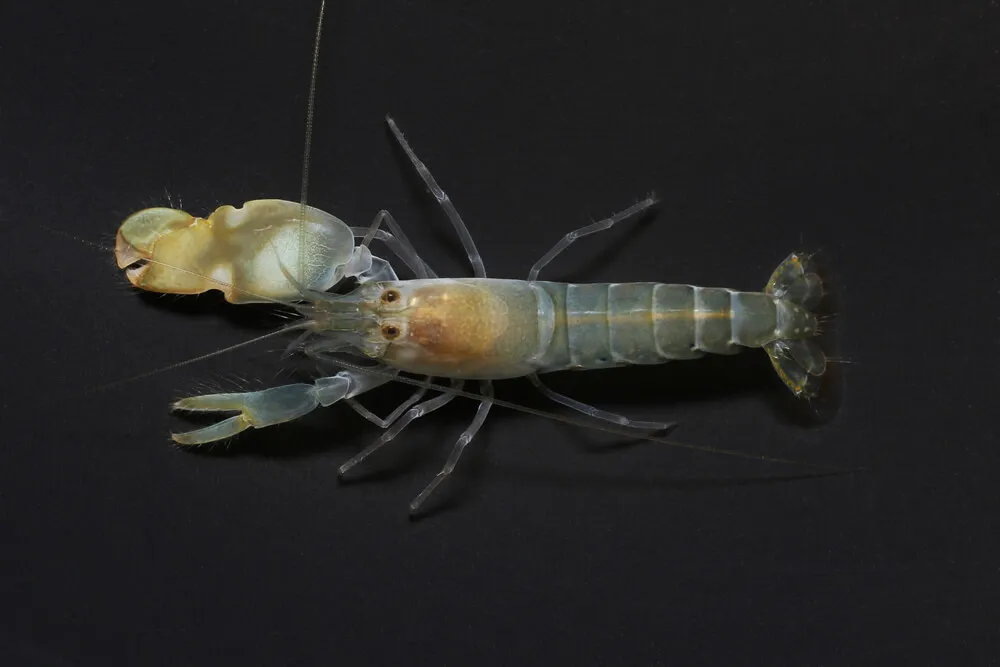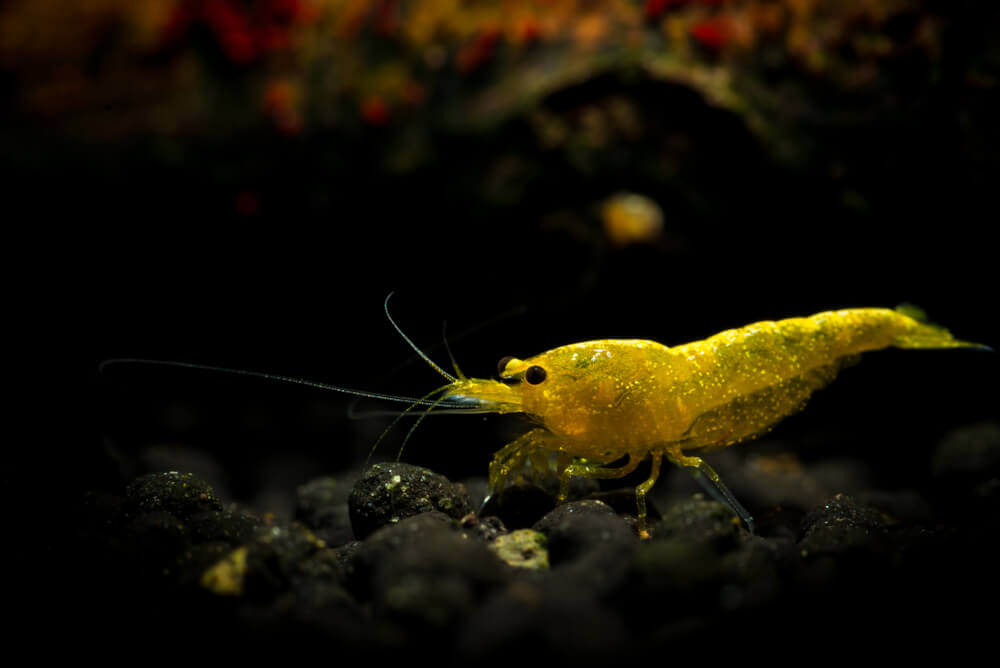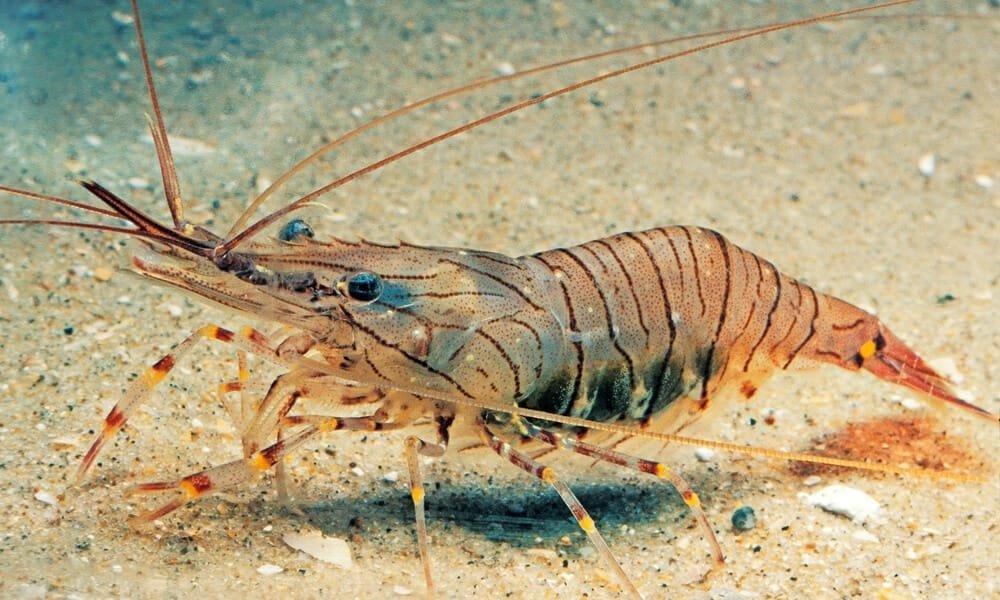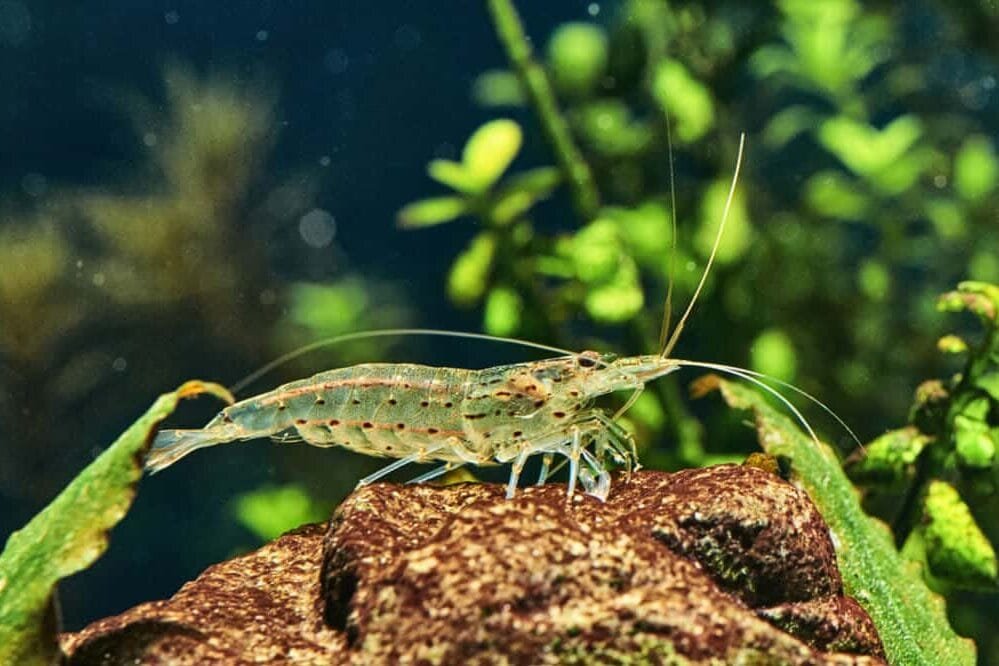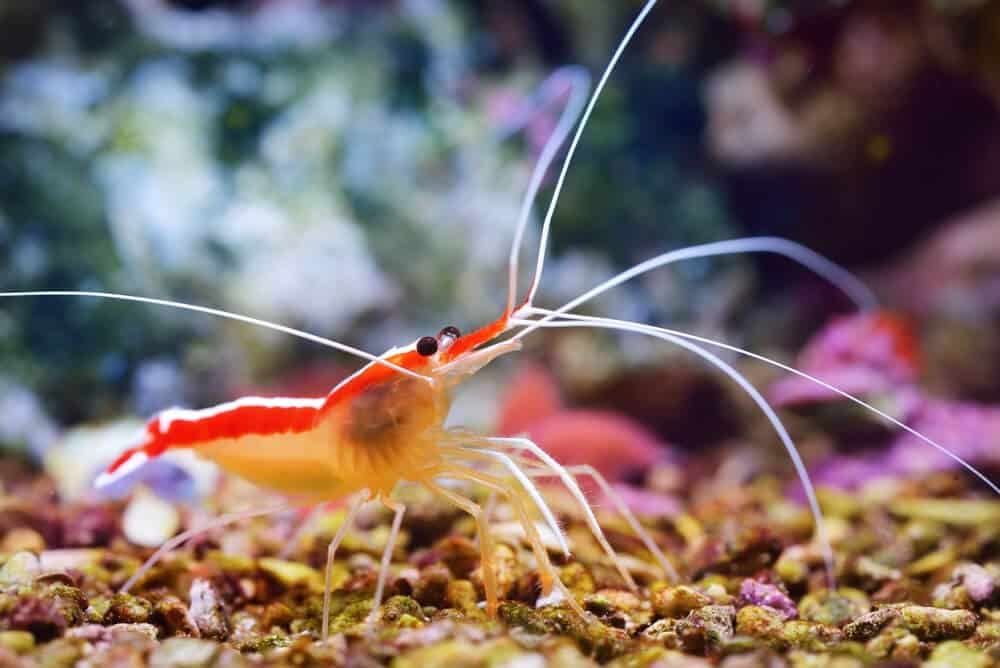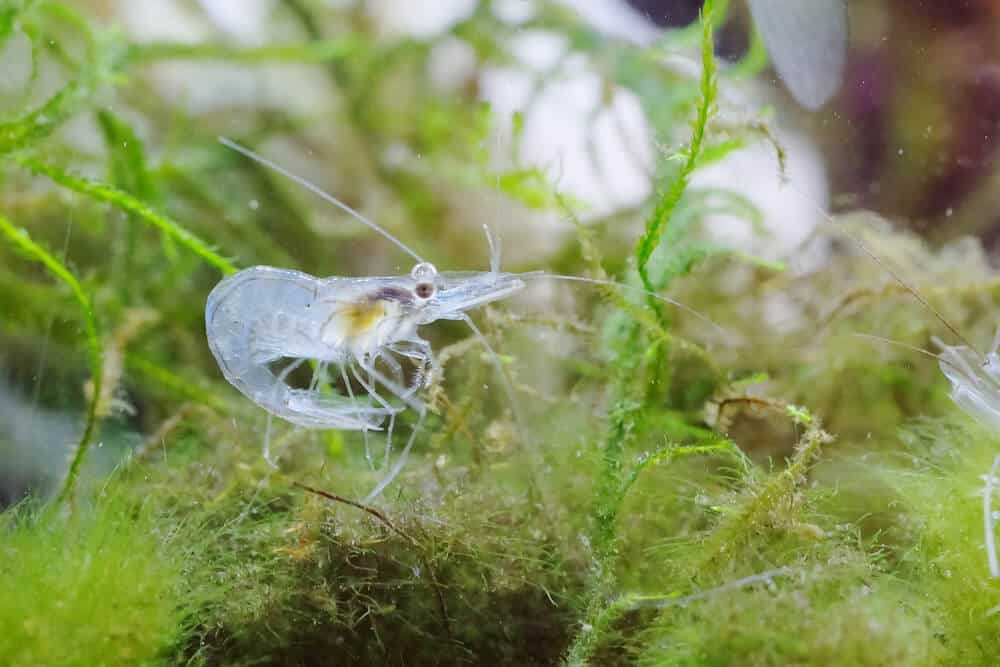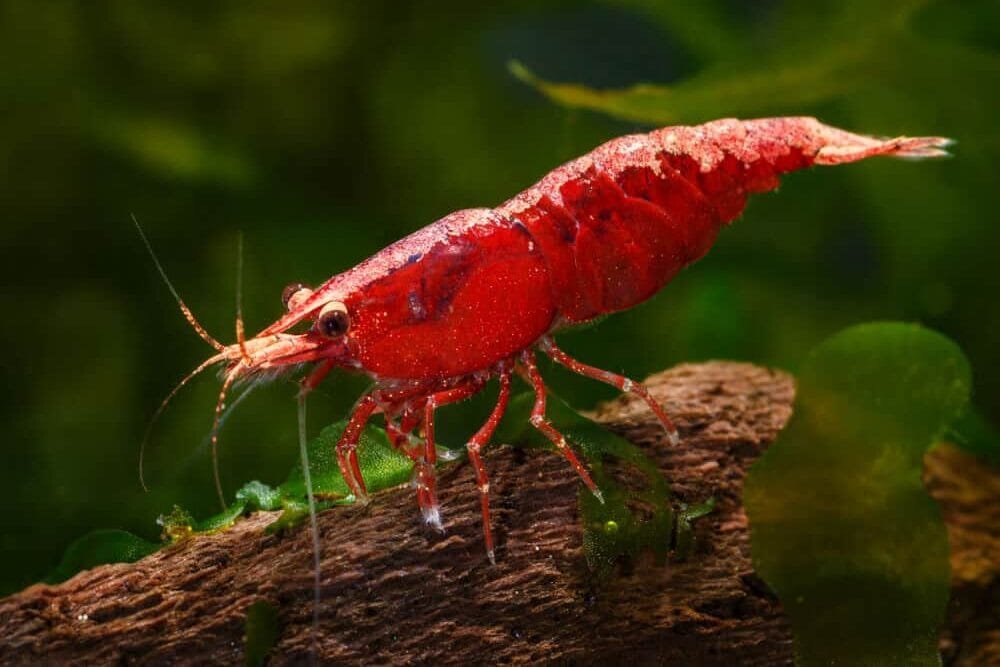Blue Velvet Shrimp Care Guide And Tank Mates
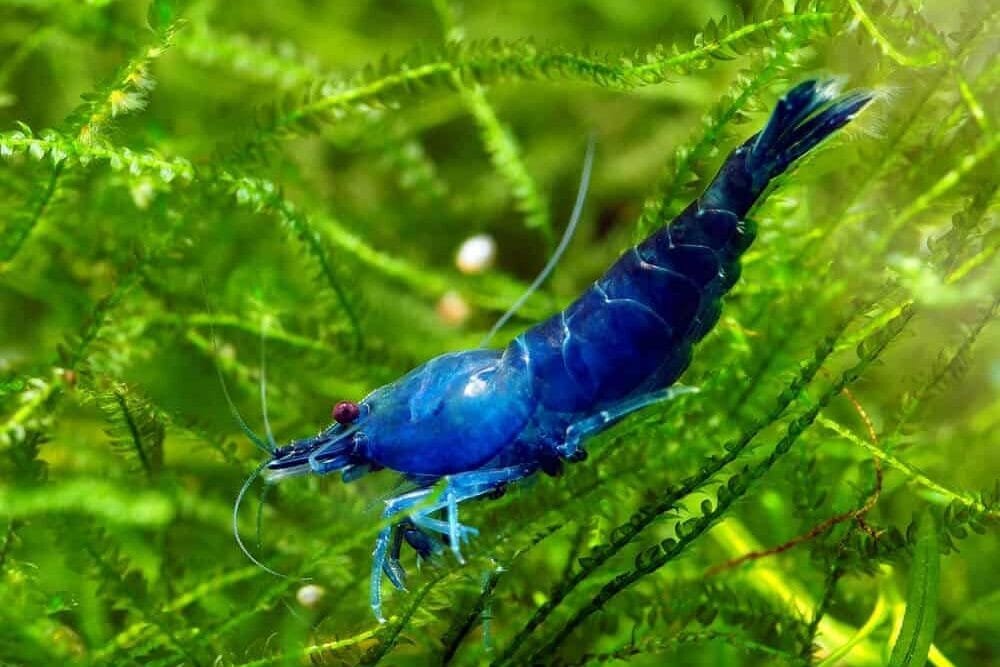
Species Overview
Common Names: Blue velvet shrimp, blue cherry shrimp
Scientific Name: Neocaridina davidi var. Blue, formerly Neocaridina heteropoda var. Blue
Adult Size: 2 inches
Life Expectancy: Approximately 2 years
Characteristics
Family: Atyidae
Origin: Taiwan
Social: Peaceful
Minimum Tank Size: 5 gallons
Diet: Omnivore
Breeding: Egg-carriers
Care: Beginner
pH: 6.0 to 8.0
Hardness: 0 to 8 KH
Temperature: 65 to 85°F
Blue Velvet Shrimps are one of the most exotic aquatic creatures. They are not only gorgeous but also very friendly, so much so that you can keep them with other types of peaceful fish.
The small-sized Blue Shrimps are easy to care for with manageable requirements and give you the convenience of saving on space. Their compatible tank mates include Neon tetra, Gouramis, Flame Tetra, and Harlequin Rasbora, among others.
You need to meet various water parameters requirements and caution when choosing tank mates. In this guide, we are going to walk you through the basics of keeping the colorful Shrimp and selecting a suitable tank mate.
Origin
The Blue shrimp is a freshwater shrimp that originates from Taiwan and can be easily found in the country’s rivers, lakes, and streams.
The velvet shrimp belongs to the Atyidae family, which includes many other types of shrimps. Its color is due to a pigment called anthocyanin, which makes up the scales on its body.
The blue morph was first described in 1918 and studied throughout the 20th century. In 2003, the shrimps were introduced to the aquarium hobby community.
Aquarists managed this through a series of selective breeding because they wanted more colors than they could find through natural selection alone.
Blue morphs have been introduced into some aquaria, but they do not appear to be very popular with aquarists. They are more challenging to breed in captivity than other color morphs such as red or orange morphs. They, however, breed effortlessly in their natural environment.
Appearance
Blue Velvet Shrimps are a type of shrimp that are more colorful than most other types of shrimp. These blue shrimp have a vibrant blue color, round bodies, and clear eyes.
The carapace (the top part of their bodies) is blue in color, but it may also be yellow, orange, or green.
They have five pairs of legs on each appendage (each leg has three segments). Their swimming legs are located at the base of their abdomen.
They also have two antennae and two antennules which they use to sense changes in water force and salinity.
The shrimps do not have pincers on their claws or carapace, but they have tiny pincers on their upper jaws. Their claws are used for grasping food, but they do not bite like other types of shrimp.
Instead, they use their long antennae to sense changes in salinity and pressure around them while they swim through the water.
One of the most interesting features of these shrimp is their swimming legs, which are located on each side of their body that helps them to move around in the water.
The front pair of the swimming legs propel it forward while the rear pair propels it backward or sideways.
This means that when swimming with its front pair raised, it will always face forward; when shrugging with its front pair lowered, it will always face backward. This allows this shrimp to maintain balance during movement within its habitat or when exploring new territory.
The shrimp grow up to be about 2 inches long, smaller than most other types of shrimp. However, females tend to be larger than males when they reach adulthood.
The shrimp has four grades that define its color. These are:
- Low Grade: Black is more prominent than blue, with black spots above the head.
- Middle Grade: Translucent and opaque hues of blue
- Medium Grade: Has opaque blue body and a faded back head.
- High Grade: This one has a dense blue body with no spots of black or lustrous spots.
Care Guide
These shrimps are easy to maintain. They are freshwater shrimp and can be acclimated to freshwater conditions as long as the temperature and water quality are suitable.
The shrimps do not need much space, but they all need access to clean water. They are very delicate to the water condition.
Your shrimp may turn pale and dull blue if you have hard water. If this happens, you need to examine the water quality to match those of your source and tank.
If you notice that your shrimp are turning pale and dull blue after a few days, there may be an issue with the water quality. If this happens to you, ask someone at your local fish store if they have any suggestions on what could be causing this reaction in the tank.
Tank Parameters
The Blue Velvet Shrimps are one of the easiest shrimp to care for, but they require specific needs to survive.
The shrimp is a good candidate for a five-gallon tank, but it also can be kept in larger tanks up to ten gallons in size. It requires plenty of hiding places and caves to enjoy its natural behavior.
They love caves, so make sure there are some in the tank for them to hide in when they feel like resting on their shell or just relaxing.
The tank should have a temperature of 72-80°F (22-26°C) with dGH of 4-10, depending on the size of the shrimp. PH can be from 6.0-8.0 depending on your home water conditions, so you may need pH test kits if you want to keep this species or other types of shrimp in your aquarium.
A 75% or higher ocean water salinity will be fine for your Blue Velvets as long as the water temperature is not too cold or too hot.
The shrimp likes algae growing in its tank, so adding algae eating plants like Java Ferns will help control algae growth while still allowing them enough hiding places to enjoy their natural behaviors.
It is essential to keep checking the nitrate levels, lest lose all your blue velvets. These are the reasons that shrimps do not entertain nitrates of above 20ppm.
● They Can’t Digest Nitrates
The shrimp’s digestive system is designed to break down both plant and animal material, which means that it can’t digest nitrates. This means that if a shrimp eats many algae, it will have trouble breaking down the algae’s nitrates and passing them out in its feces.
● Transparent Gills
If you look at the gill arches on your shrimp tank, you’ll notice that they’re almost entirely transparent. This allows you to see how much food your shrimp has eaten at any given time without opening up their tank or looking inside.
If there are high levels of nitrates in their water column, then they won’t be able to get enough oxygen to survive and will eventually die off.
● Nitrate Can Be Harmful to Other Marine Life in the Tank
High levels of nitrates can harm other animals living in the tank, as well as plants growing on live rock and coral skeletons. It can bind with the hemoglobin in the blood of the fish, forming methaemoglobin.
Methaemoglobin can cause a condition called methemoglobinemia. This can be fatal since it prevents proper distribution of oxygen in the blood.
Diet
These shrimps are omnivores, meaning they eat both plant and animal foods. They will eat algae and microscopic organism biofilm, but they also like to eat snails and other invertebrates.
The shrimps will scavenge the substrate for algae, decaying organic matter, and other microorganisms. They eat live or dead plant material, like lettuce, spinach, cucumbers, and broccoli.
If you feed them nothing but algae, they will eventually die from malnutrition. This is because of the high nitrate content in their diet. Algae contains many nitrates which are toxic to the shrimp’s health.
If you want to keep your shrimp healthy and happy, you need to feed them something other than algae.
Fortunately, many foods can be used for your shrimps, including pellets, flakes and frozen foods, which can be bought from pet stores or online stores such as Amazon India.
Shrimp pellets are also a popular food for shrimps because they contain a high amount of protein and don’t require additional water to digest them. There are many different types of pellets available on the market, including shrimp pellet diets, shrimp pellet supplements, and artificial diets made from algae or similar ingredients.
If you’re feeding them live foods, ensure they’re new and alive. If you’re feeding them frozen foods, ensure they’re thawed and not frozen solid.
These shrimps are nocturnal creatures who spend most of their time hiding from predators in the substrate of your aquarium. They can be pretty elusive because they move very slowly through the substrate and often seem confused when you try to catch them.
Their presence is usually easy to spot if you keep an eye on your tank’s water level or use a siphon vacuum to remove debris from the bottom of your tank.
Shrimp are filter feeders, meaning they ingest food particles that float. If there is a lot of copper in the water, then more of this toxic element will end up in your shrimp’s food. This can be harmful to their health and survival rate.
If you give your shrimp any fish food containing copper, they will absorb some of it through their gills and blood stream into their bodies. You might notice that your shrimp become lethargic after eating such food because it has too much copper for them to handle at once.
Behavior
Blue Velvet Shrimps are extremely peaceful shrimp. They are described as timid and likely to hide in caverns or under rocks during the day. They are also active at night.
The shrimp may share their hiding place with other species of shrimp. When they are active, they scavenge for food such as algae, micro-organisms, and dead foods.
The shrimp will hide more during the shedding process. The exoskeleton is a protective shell that covers the shrimp’s body, and when shed, the shrimp will hide in a small crevice or area where they can regenerate their shell. They may also curl up into a ball and become harder to see.
The adults will molt once every month, and juveniles will molt about once a week. This can be disruptive to their fellow tank mates, so it is paramount not to disturb them when they are molting, as they can be injured if handled too much.
Breeding
Breeding on their own is the easiest way to get these Shrimp. They are easy to care for but require special attention during the breeding season.
During this time, it is essential to keep them well fed, water parameters stable, and temperature at proper levels. If all these things are done properly, the shrimp will be able to breed independently.
If you want to keep breeding shrimp in your aquarium, you should start by feeding them nutritious food from day one. This will help them grow faster and become more resilient to stressors like disease.
The key thing that makes breeding successful has a male shrimp present in the breeding tank with a female. This way, there is no competition between males and females, so breeding can occur without any problems.
It is also important not to overcrowd your shrimp tank as this increases stress levels in both the shrimp and their environment, which could cause problems during the breeding season.
If you are breeding this shrimp, it is essential to remove any tank mates, even if they are peaceful from the shrimp tank mate when it is breeding. That includes other shrimp, snails, and scallops. The baby shrimp will need all the protection they can get.
The juveniles are vulnerable during this stage, so it’s best to keep them in a nursery tank until they are fully grown. You can also protect them with a sponge strainer and a strip of Java moss.
It is also recommended that you try as much as possible to keep the tank temperatures consistent during breeding to keep the young ones comfortable without stress.
Female shrimps are bright blue when entering the breeding period, and the body gets rounder when preparing to carry eggs. Females are capable of laying about 60 eggs in one round.
The male shrimp will mate with any female put in his tank, but he will only fertilize the female. The eggs are dropped into the water, and the female will carry them around until they hatch out at about 20 days of age.
After hatching, remove females then give powdered algae flakes to young ones.
Most Suitable Tank Mates
The Velvet Shrimp is a peaceful fish that loves to be the center of attention. They are also known to get along with other types of tank mates, but they need special care due to their delicate nature.
It is essential to research the best tank mates for reasons of compatibility. You do not want to introduce shrimps to fish that will threaten or eat the beautiful shrimps into the tank.
These shrimp are best kept with other peaceful species of shrimp, but they can be kept controlled with some small catfish if they are a good size (1-2 inches). Large catfish may eat smaller shrimps.
Here are some of the best tank mates to couple up with these shrimps:
1. Neon Tetra
The Neon Tetra and Shrimp are the perfect tank mates for each other. Both fish are small, peaceful, and colorful. Additionally, both species enjoy eating the same foods. The shrimp will eat the leftovers left in the tank by the tetras.
The best part about neon tetra fish is that they don’t have much aggression towards other fish species, so you can keep them in the same tank with different types of fish without any problems.
The two fish species would also benefit from having plenty of objects to hide behind and rocks to jump from.
2. Gouramis
Gouramis are also perfect tank mates for shrimps that can add color to your tank.
They are peaceful and non-aggressive, which makes them ideal for new tank owners. They will not eat your shrimp.
Gouramis will also clean up any uneaten food in their tank, just like the velvet shrimps, which can be helpful if you have many algae growing in your display. Their diet consists primarily of algae and vegetable matter such as cucumber or zucchini slices.
3. Flame Tetra
Both of these fish are peaceful, but they need a large tank because they can grow to be very large. The Flame Tetra is a very active fish that loves to eat and will do so as often as possible.
It has a diet that consists of algae and small insects, so it should be fed with pellets once every day or two. The Shrimp is also an omnivore so that it will eat many different kinds of foods, including flakes and pellets.
4. Harlequin Rasbora
Harlequin Rasboras are an excellent fish for the community aquarium. They can be kept with other species of fish or invertebrates such as shrimp. They are peaceful, hardy, and easy to maintain. They thrive in mixed communities as long as there is enough room for them to swim freely.
Frequently Asked Questions
What fish can live with shrimp?
The shrimps are remarkable for keeping with fish that don’t eat much algae or plants, such as Cichlids, Bettas, and Loaches. They will also do well with other freshwater fish such as Tetras, Barbs, and Guppies.
Do shrimps need a filter?
Some people say yes, and some say no. You can use a sponge filter if your tank is small enough, or you could just let them swim around without any filtration at all. If you decide to have them on a filter, make sure it’s a good one with solid filtration because they love to hide under rocks and plants, so they need plenty of places to hide too.
What can I feed the Blue shrimp?
The shrimps are omnivores, meaning they eat both plant and animal material. They like to eat algae and small crustaceans like snails and any other type of bug you can think of.
They also love floating plants such as duckweed and water lettuce, so make sure you provide plenty of these in the tank, so they will thrive.
How many shrimp can I put in a 20-gallon tank?
There are a few things to consider when deciding how many shrimp you can put in your aquarium. First, the size of your tank is important because it will affect how many shrimp you can keep in there.
If you have a small tank, only one or two shrimp should be considered, while larger tanks might allow for up to four shrimp per gallon.
How long does it take for the shrimp to grow?
Shrimp’s growth depends on many factors, but it takes about 6 to 8 weeks for them to develop from 1 inch to 3 inches in length. The size at which they mature depends on the temperature of the water, food, and other factors such as how much light they receive.
It takes about two to three months from the time you get your shrimp and place them in the tank until they are ready to eat.
The best way to ensure that you get a healthy shrimp is to buy one that has already been acclimated for at least two weeks in the store.
Final Thoughts
Overall these shrimps are pretty easy to keep in a tank and are not demanding. So, if you have been having your fears about keeping some in your aquarium, it’s time to brace up for the beautiful creatures.
In a ten-gallon tank, one can comfortably keep up to four Blue Velvet Shrimps as long as water parameters are sound. Maintaining the water heater at 78°F and adding an aquarium will be ideal for the shrimp’s freshwater habitat.
Remember that these animals require plenty of oxygen, so don’t overcrowd them in their home. Also, filter flow should be restricted to maintain the optimal environment.
If you are planning to get these shrimps to add your aquarium, go for it! But, make sure to take note of the information mentioned in this article so that they’ll thrive and live for long.
